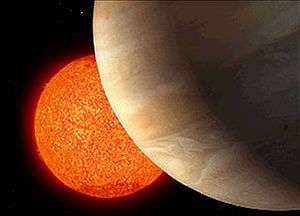Iota Draconis b
| Exoplanet | List of exoplanets | |
|---|---|---|
 | ||
| Parent star | ||
| Star | Iota Draconis | |
| Constellation | Draco | |
| Right ascension | (α) | 15h 24m 55.7747s |
| Declination | (δ) | +58° 57′ 57.836″ |
| Apparent magnitude | (mV) | 3.29 |
| Distance | 101.2 ly (31 pc) | |
| Spectral type | K2III[2] | |
| Mass | (m) | 1.82 (± 0.23)[2] M☉ |
| Radius | (r) | 11.99 (± 0.06)[2] R☉ |
| Temperature | (T) | 4545 (± 110)[2] K |
| Metallicity | [Fe/H] | 0.14[2] |
| Age | 10.015[3] Gyr | |
| Physical characteristics | ||
| Minimum mass | (m sin i) | 8.82 (± 0.72) MJ |
| Radius | (r) | ~12 R⊕ |
| Stellar flux | (F⊙) | 34.3 ⊕ |
| Temperature | (T) | 598 K (325 °C; 617 °F) |
| Orbital elements | ||
| Semi-major axis | (a) | 1.275 (± 0.074) AU |
| Eccentricity | (e) | 0.7124 (± 0.0039) |
| Orbital period | (P) | 511.098 (± 0.089) d (1.4 y) |
| Argument of periastron |
(ω) | 91.58 (± 0.81)° |
| Time of periastron | (T0) | 2,452,014.59 (± 0.30) JD |
| Semi-amplitude | (K) | 307.6 (± 2.3) m/s |
| Discovery information | ||
| Discovery date | January 8, 2002 | |
| Discoverer(s) | Frink et al. | |
| Discovery method | Doppler Spectroscopy | |
| Discovery status | Confirmed | |
| Other designations | ||
| Hypatia, HD 137759 b, HIP 75458 b | ||
| Database references | ||
| Extrasolar Planets Encyclopaedia | data | |
| SIMBAD | data | |
| Exoplanet Archive | data | |
| Open Exoplanet Catalogue | data | |
Iota Draconis b, also named Hypatia, is an exoplanet orbiting the K-type giant star Iota Draconis about 101.2 light-years (31 parsecs, or nearly 2.932×1014 km) from Earth in the constellation Draco. The exoplanet was found by using the radial velocity method, from radial-velocity measurements via observation of Doppler shifts in the spectrum of the planet's parent star. It was the first planet discovered orbiting a giant star.[4]
Following its discovery the planet was designated Iota Draconis b. In July 2014 the International Astronomical Union launched a process for giving proper names to certain exoplanets and their host stars.[5] The process involved public nomination and voting for the new names.[6] In December 2015, the IAU announced that the winning name for this planet was Hypatia.[7] The winning name was submitted by Hypatia, a student society of the Physics Faculty of the Universidad Complutense de Madrid, Spain. Hypatia was a famous Greek astronomer, mathematician, and philosopher.[8]
Characteristics
Mass, radius and temperature
Iota Draconis b is a "super-Jupiter" a planet that has a radius and mass larger than that of the gas giants Jupiter and Saturn. It has a temperature of 598 K (325 °C; 617 °F). It has an estimated mass of around 8.82 MJ and a potential radius of around 12 R⊕ based on its mass, since it is more massive than Jupiter.
Host star
The planet orbits a (K-type) giant star named Iota Draconis. The star has exhausted the hydrogen supply in its core and is currently fusing helium. The star has a mass of 1.82 M☉ and a radius of around 12 R☉. It has a surface temperature of 4545 K and is about 10 billion years old based on its evolution.[3] In comparison, the Sun is about 4.6 billion years old[9] and has a surface temperature of 5778 K.[10]
The star's apparent magnitude, a measure of how bright it appears from Earth, is 3.31. Therefore, Iota Draconis can be seen with the naked eye.
Orbit
Iota Draconis b orbits its star with nearly 55 times the Sun's luminosity (55 L☉) every 511 days at a maximum distance of 1.275 AU (compared to Mars' orbital distance from the Sun, which is 1.52 AU) It has a very eccentric orbit, with an eccentricity of 0.7124.
Discovery
Discovered in 2002 during a radial velocity study of K-class giant stars, its eccentric orbit aided its detection, as giant stars have pulsations which can mimic the presence of a planet.[4]
References
- ↑ Butler; Wright, J. T.; Marcy, G. W.; Fischer, D. A.; Vogt, S. S.; Tinney, C. G.; Jones, H. R. A.; Carter, B. D.; et al. (2006). "Catalog of Nearby Exoplanets". The Astrophysical Journal. 646 (1): 505–522. arXiv:astro-ph/0607493
 . Bibcode:2006ApJ...646..505B. doi:10.1086/504701.
. Bibcode:2006ApJ...646..505B. doi:10.1086/504701. - 1 2 3 4 5 Baines, Ellyn K.; et al. (December 2011), "Fundamental Parameters of the Exoplanet Host K Giant Star ι Draconis from the CHARA Array", The Astrophysical Journal, 743 (2): 130, arXiv:1109.4950
 , Bibcode:2011ApJ...743..130B, doi:10.1088/0004-637X/743/2/130
, Bibcode:2011ApJ...743..130B, doi:10.1088/0004-637X/743/2/130 - 1 2 Safonova, M.; Murthy, J.; Shchekinov, Yu. A. (2014). "Age Aspects of Habitability". International Journal of Astrobiology. 15 (2): 93–105. arXiv:1404.0641
 . doi:10.1017/S1473550415000208.
. doi:10.1017/S1473550415000208. - 1 2 Frink; Mitchell, David S.; Quirrenbach, Andreas; Fischer, Debra A.; Marcy, Geoffrey W.; Butler, R. Paul (2002). "Discovery of a Substellar Companion to the K2 III Giant Iota Draconis". The Astrophysical Journal. 576 (1): 478–484. Bibcode:2002ApJ...576..478F. doi:10.1086/341629.
- ↑ NameExoWorlds: An IAU Worldwide Contest to Name Exoplanets and their Host Stars. IAU.org. 9 July 2014
- ↑ NameExoWorlds The Process
- ↑ Final Results of NameExoWorlds Public Vote Released, International Astronomical Union, 15 December 2015.
- ↑ NameExoWorlds The Approved Names
- ↑ Fraser Cain (16 September 2008). "How Old is the Sun?". Universe Today. Retrieved 19 February 2011.
- ↑ Fraser Cain (September 15, 2008). "Temperature of the Sun". Universe Today. Retrieved 19 February 2011.
External links
Coordinates: ![]() 15h 24m 55.7747s, +58° 57′ 57.836″
15h 24m 55.7747s, +58° 57′ 57.836″